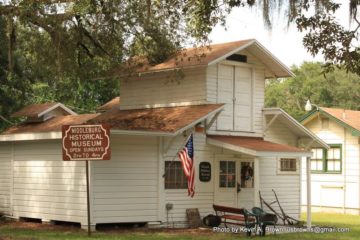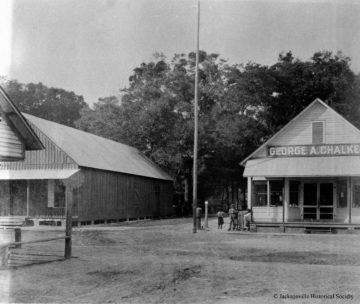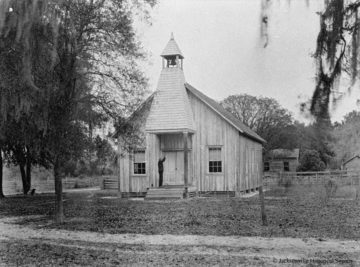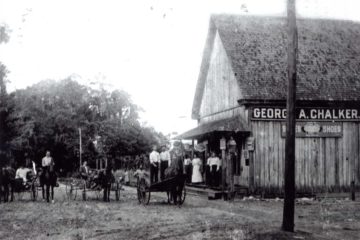Middleburg began in the 19th century with several different names. It was first known as Clark’s Ferry from the 1820s to 1833. The name derived from Asa Clark who ran the ferry until 1828. In 1828 the Black Creek Methodist Church was founded by Isaac Boring but the frontier Methodist society met in their own homes until the Methodist United Church was built in 1847.[5] Fort Heilman protected settlers at Clark’s Ferry where it was the “principal depot for the east coast of Florida.”[6] During the Seminole Wars Fort Heilman was used as a quartermaster workshop and storage depot but was abandoned after the war in 1841.[7] From 1833 to 1850 the area was then known as Gary’s Ferry after Samuel Y. Gary. On September 8, 1853 the area was finally called Middleburg. The new town traded in timber, citrus fruits and crops from farmland. When Clay county was created in 1858 Middleburg became the temporary county seat until 1874.[8]
The 4th Massachusetts Cavalry had a small skirmish before raiding Middleburg during the American Civil War on October 23, 1864. The next day the 4th Massachusetts Cavalry set fire to a number of buildings and a hotel. The Federals retreated across Black Creek burning a bridge in the process. The 2nd Florida Cavalry caught up with the retreating 4th Massachusetts Cavalry in a skirmish at Halsey’s Plantation.[9]
There is no place in Florida richer in history than the village of Middleburg. Located between the forks of Black creek in Clay county, about twenty-eight miles southwest of Jacksonville. At one time, Middleburg was the principal port for water shipments in the state; that was back in 1840-1850. Boats came up Black creek from the St. Johns river and loaded with lumber, crossties, wood and cotton. Black creek is a very deep stream and in places is over a quarter of a mile wide. Boats of fairly deep draft can navigate it easily.
The writer, in delving into the past of Middleburg, was told that about ten years after the settlement of St. Augustine, several Spanish families, desiring to engage in farming, moved back into the interior on Black creek near where Middleburg now stands. Among these families were Tarattus, Alvarez, Andrew and Dilabury. Many of the descendants of those families are now living in that section. It is not known what the Spaniards called the settlement, but the Alvareses and Andrews moved on further back to what is now Bradford county. Later, in 1820-25, many
American families moved to the same location, among them being the Tippins, Branning, Tegister, Chalker, Frisbee, Prevatt, Snowden and Burdin families. Today they are engaged in C (sic) farming, and quite a town was built up at that time, larger than the village of Bowford, now Jacksonville. Middleburg was then called the town of Black Creek, the creek being so named because the water is nearly jet black.
House Still Stands
In 1840, the Chalkers built a large two-story house. It is still standing and in it lives Mrs. M. A. Chalker, age 84, who is one of the oldest residents of Middleburg. The Methodist church used by the early settlers is still in good shape and is being used. It was constructed in 1847. The Brannings were wealthy aristocratic southerners. They had a large plantation and farmed it with over 100 slaves. The plantation had its own shoe factory, blacksmith shop and commissary. Back in the early days before and during the Indian war, it is stated that the Indians had a large camp on the shores of Black creek near the present town of Middleburg. They foraged as far away as South Georgia. Along about that time, as it is stated, a band of pirates made a camp on the shores of the creek near the Indian camp and built up quite a village. They used this as their hiding place, dashing out at times into the St. Johns river, thence to the ocean where they would loot some unfortunate ship and then dash back to their rendezvous. It is stated that the pirates had trouble with the Indians and a band of old Billy Bowlegs ‘ followers slaughtered them all in a pitched battle one day, but this is merely hearsay. No history records a battle of that nature being fought. However, it is a fact that there was a fort at that location during the Seminole Indian war. Several companies of United States soldiers engaged there until the Indians were driven further south. Old residents say that a Mrs. Snowden, with others, was in the fort with six children. She took a notion she wanted to her home. All tried to dissuade her from this move. She went and the Indians captured her, stood the six children in a row, shot them and left Mrs. Snowden for dead. However, she recovered, and scouts coming along found her and took her to the fort.
Woman Compiles Data
Mrs. Minnie B. Prevatt has prepared some interesting data of early Middleburg. She says; “Much has been said about St. Augustine, the oldest town in the United States, but comparatively little is known of Middleburg, the second oldest town in the United States. On the Rideout road near Russell, about five miles from Green Cove Springs, there was an Indian town as late as 1855. The huts, which were built largely of palmetto, stood for a number of years after the Indians left. The Indians would leave their town, go down Peters creek to St. Johns River to the St. Johns bar where they would get oysters. The land where this Indian town stood was later homesteaded by John Barrows, Sr. Many of the creeks and landings were give the names of pioneers who were killed near there by the Indians. Bull Creek was named after a man by the name of Bullman who was killed by Indians while plowing. Indian Fort, on the north prong of Black creek near Middleburg, was given the name because a Mr. Beasley was killed there by the Indians while and George Branning were crossing the creek. Mr. Beasley’s horse had stopped to drink and an Indian hiding at the edge of the water shot him with an arrow and killed him. Branning was not harmed as he was an interpreter for the Indians.”
“These first settles lived on wild meat, rice, potatoes and barley. One night George Branning, one of the oldest settlers, and his two brothers, Bill and Bob, were eating supper by their camp fire when an Indian shot an arrow from across the creek and killed Bob. The other two brothers threw water on the fire so they would not be seen.”
Former Battle Site
“One of the battles of the Civil war was fought between Green Cove Springs and Middleburg, three and one-half miles west of Old Town. It was called the battle of Tiger Head. Captain Dickinson was leading Confederate soldiers. The Yankees were successful and among the Southern soldiers that they captured was Wash (or Nash) Branning. He was sentenced to be shot in front of Mrs. Bill Knight’s house. There were two Knight girls, Sue and Rhoda. The Yankee guard allowed Branning to go to the door of the Knight house to give Sue his old fashioned watch. He handed it to her, jumped the high gate, tore off his clothes and jumped into Black Creek. He was reported drowned by the Yankees. Late that night he went to Tom Dilabury’s and got clothes.”
Clay and St. Johns counties were part of Duval county in those days and court was held at St. Augustine. In 1855, more than seven hundred people lived in Middleburg. Later the courthouse was moved there and it was known as Webster. Before the Civil War two of the largest slave holders were George Branning and Osias A. Beddington. Beddington was a sea captain. He was born November 26, 1796, and died August 24, 1886. His remains rest in the old family cemetery at Middleburg. G.A. Prevatt was also one of the old settlers, going to Middleburg in 1851.
When Middleburg was in its prime of business, the leading stores were owned by W. Warrick, Captain John G. Richard, Peter?, Jesse Branning and Thomas Hedges. There were two churches in the town, Catholic and Methodist. The old bell for the Methodist church was bought n New York in 1855 and sounds its tones to bring people to church today. Also a piano owned by the Beddingtons is to be found in an old house in Middleburg.
Today, while only a small town, Middleburg is ambitious to become larger. It has several stores, is ideally located and is surrounded by some of the best farming land in the state. Several new improvements have been made there recently, among them the establishment of the Middleburg Lodge by Mrs. C. Ray Greene, who plans to show sportsmen and fishermen of Jacksonville that Middleburg and Black creek constitute some of the best hunting and fishing grounds in the South. Mrs. Greene believes that when Middleburg becomes better known and the value of its lands and fishing and hunting is found out it will again come into its own and become one of the important towns of Florida.












